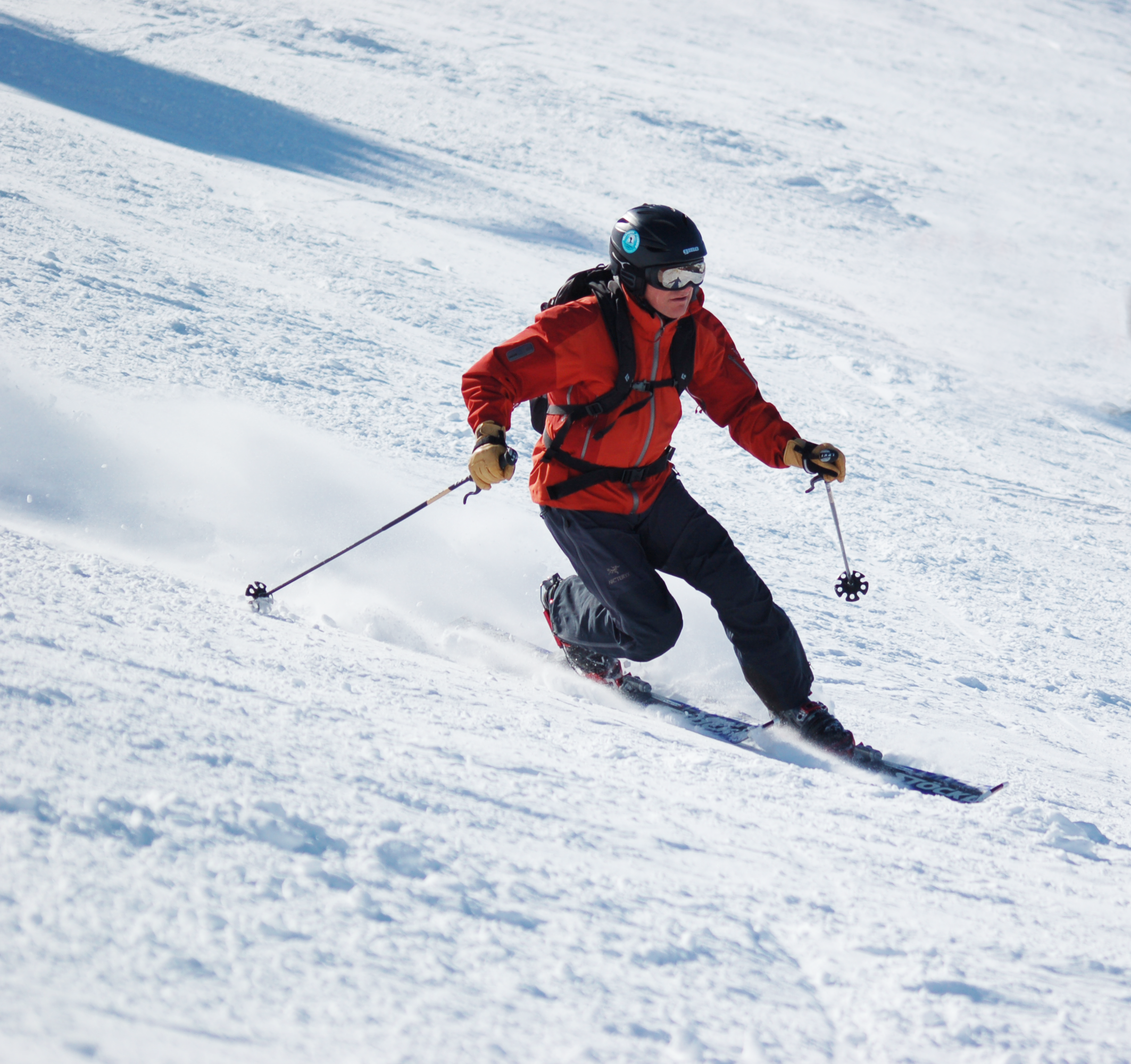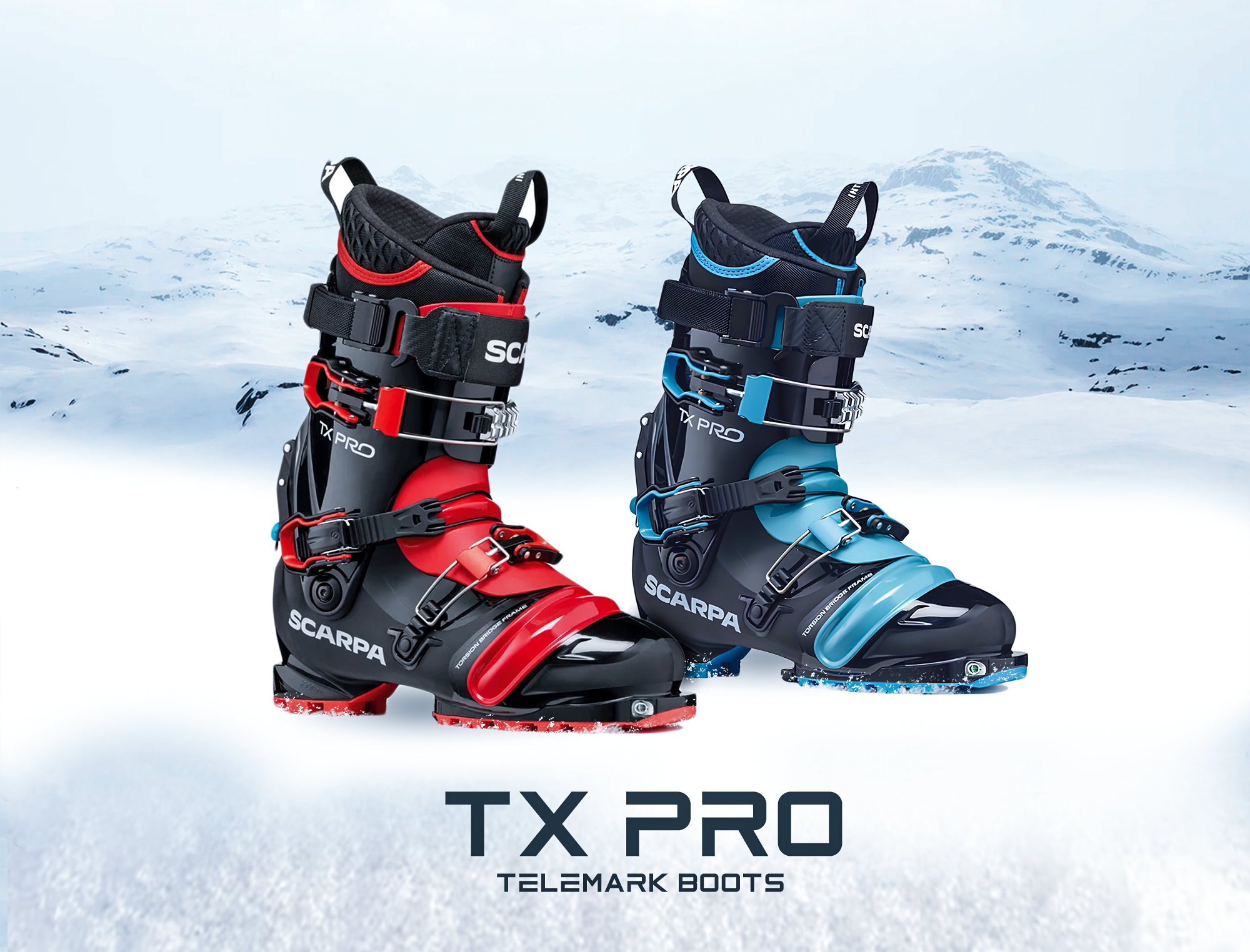
The result of 15 years research and development, Scarpa’s latest telemark boots hit the slopes winter 24/25. Long awaited, the new TX Pros are set to raise the level of what’s possible when telemark skiing, both on piste and in the backcountry. In all sports, whether it’s carbon fibre tennis racquets or kevlar sails, technological advances work in tandem with human performance to determine what’s possible. To understand why the new Scarpa TX Pros are so important, it helps to know how telemark boots and bindings have evolved over the last 30 years.
A LITTLE HISTORY
Click HERE to jump to TEST if you already know this stuff...
1993 - THE FIRST PLASTIC TELEMARK BOOTS
Scarpa has always been at the forefront of telemark boot design. With the launch of the legendary Terminator in 1993, Scarpa were the first company to develop a plastic telemark boot, offering new levels of performance for freeheel skiers. Over the following 14 years they developed 5 models with the 75 mm boot sole for every type of skiing, from stiff and high resort boots (T1 & T Race), all round resort + touring (T2) and lighter nordic touring models (T3 & T4).
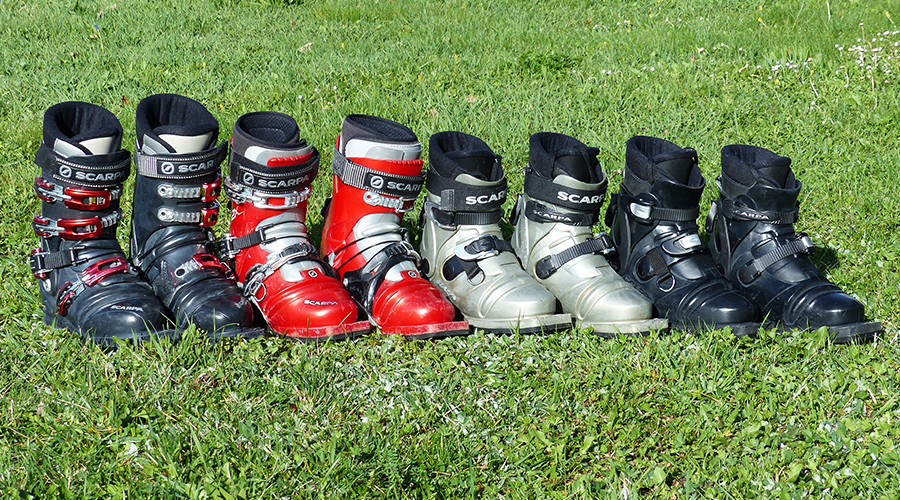
Scarpa 75 mm boots T1, T2, T3 & T4. Hibernating in the garage, waiting for that retro day.........
Each iteration introduced design improvements including asymmetric bellows, the 2nd buckle that locks the heel down, soles with rocker for touring or flat for immediate turn initiation, and dual & triple-injection “Powerframe” shells.
As telemark boot performance increased, the limitations of the 75 mm system became increasingly evident. A more modern binding standard was needed.
2007 - THE NEW TELEMARK NORM
Working together with the Norwegian binding manufacturer Rottefella, Scarpa launched the NTN (New Telemark Norm) system in 2007.
Scarpa’s 3-buckle TX and the 4 buckle TX Pro and TX Comp did away with the 75 mm duckbill and instead used a wide rounded toe unit combined with a protruding ledge under the ball of the foot that connected to the “2nd heel” of the bindings.
The NTN system provides a very solid boot-binding connection, good power transmission to the skis and was soon the preferred binding for strong aggressive skiers and tele racers.
NTN CAME WITH INSERTS
For a short while in the early 2000s alpine ski tourers found they could climb faster if the boot shell had bellows, allowing the foot to flex to give a longer stride (the boots also flexed in downhill mode, so this design was abandoned after a few years). Scarpa produced two AT models with bellows, the original F1 & the F3. These boots looked superficially similar to telemark boots.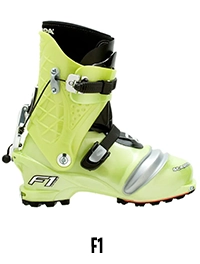
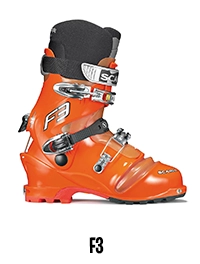
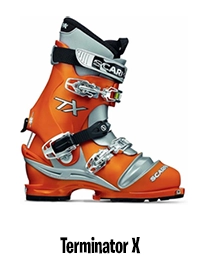
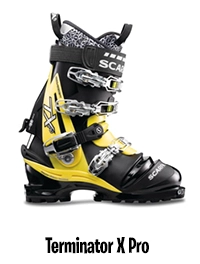
Scarpa must have wanted to cover all bases when introducing the NTN boots, adding “tech” inserts at the boot toe and heel so that these boots could eventually be re-purposed for use with alpine touring bindings in the event that NTN didn’t take off.
Luckily NTN was a success and while Scarpa never had to look for alternative uses for these boots, many skiers were wondering how to make use of these inserts.
2007-2011: 75 mm + NTN
From 2007 there were two telemark binding standards. The original 75 mm standard models offered low weight and more or less adequate performance while the NTN bindings supplied plenty of power - and weight. Neither system offered practical touring, step-in or reliable release, and enterprising telemarkers were making DIY bindings combining features of tele and AT bindings.
2011: TELEMARK TECH SYSTEM
In 2011 Mark Lengel invented the 1st binding to combine a Dynafit style “tech” toe unit with a cable heel unit. These bindings were lighter and the tech toe unit supplied a much more direct boot-binding connection than either the 75 mm or NTN systems could provide, driving yet more power to the skis. This design became known as the Telemark Tech System (TTS) and Voile has recently produced the TTS Transit, the first TTS binding from an established telemark brand.
In 2014 22 Designs produced the Outlaw X, a powerful NTN binding that is lighter than the Rottfella models and came with step-in. This model soon became the most popular NTN binding.
2015: 2-PIN-NTN
In 2015 Pierre Moyade produced the ground breaking Meidjo, combining a tech toe with the “2nd heel” of the NTN design. Weighing under a kilo per pair, featuring lateral release, step-in, efficient touring and good downhill performance, the Meidjo offered a step increase in overall binding performance and 22 Designs soon produced the Lynx, using the same tech toe or 2-Pin-NTN design.
2024 BINDING SUMMARY
We now have 7 telemark bindings using mature technologies:
NTN: Rottefella NTN Freeride (resort) and Freedom (touring), 22 Designs Outlaw X (touring) and Bandit (resort).
TTS: Voile TTS Transit
2-PIN NTN: Inwild Meidjo & 22 Designs Lynx

SO WHAT ABOUT THE BOOTS?
We’re STILL using the same Scarpa TX Pros from 2007, albeit with new colours, or the Crispi and Scott versions of the same technology. It’s notable that ALL innovations in plastic telemark boot technology have been made by Scarpa.
Mechanically, telemark boots are far more complicated than alpine or AT boots. A telemark boot shell has to flex and also give lateral stiffness, using plastics that are durable and retain their mechanical properties for 10s of thousands of flex cycles over a range of temperatures. Developing these boots takes many years and it’s not surprising that Scarpa have waited until now before releasing a new boot - they needed to wait until binding standards were (more or less) agreed.
Scarpa have been working on a new generation telemark boot for several years, and we tested a prototype three years ago. It was good to know that Scarpa were working on a new boot and the online telemark community has been buzzing with rumours and sightings of test models for quite awhile. Scarpa has taken the time to make sure all bases are covered before going to production.
That’s enough of the preamble, how do the boots perform?
SCARPA TX PRO 2024 TEST REPORT
Spoiler Alert - FANTASTIC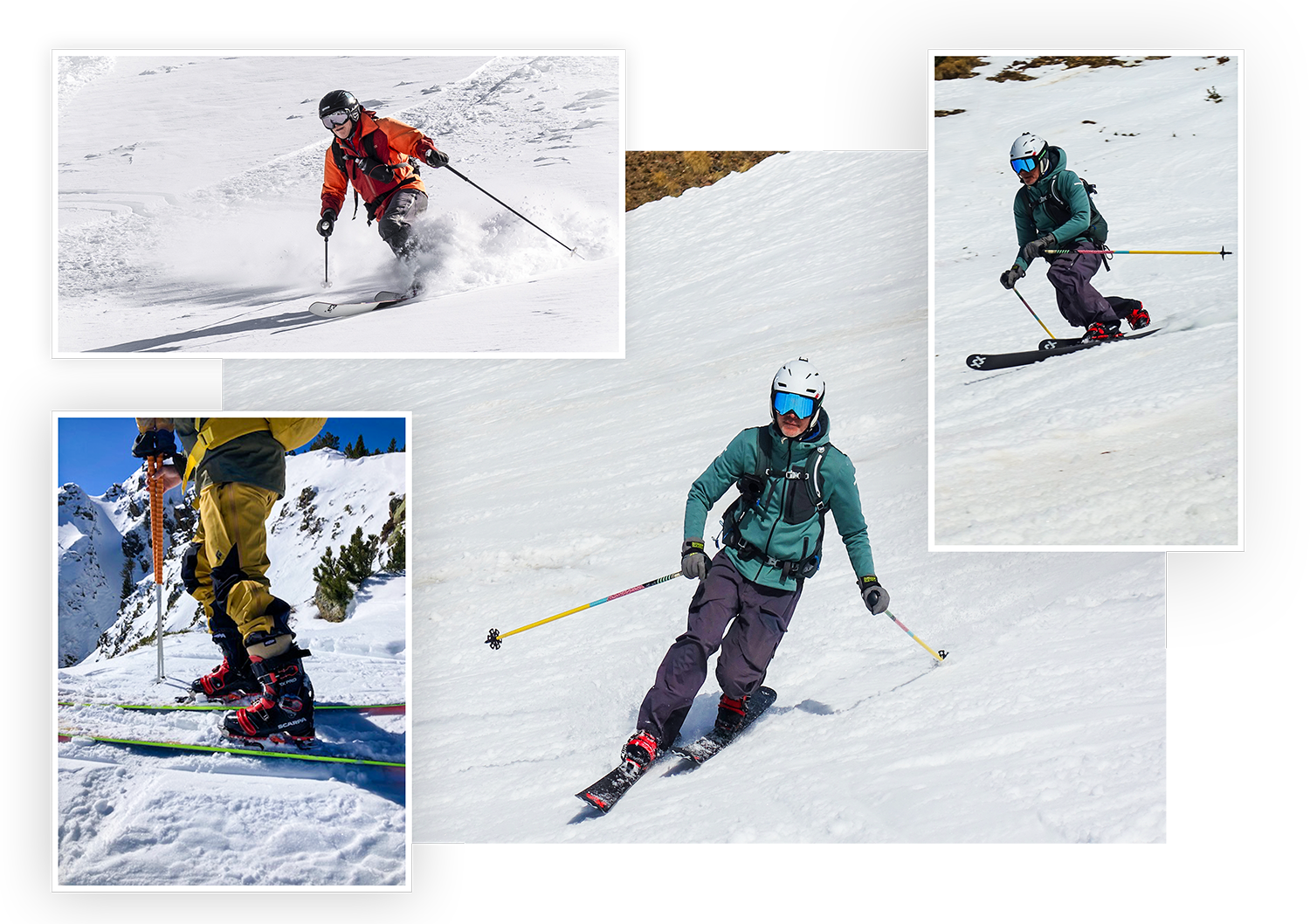
At Telemark Pyrenees we’ve been very fortunate to have been able to test the TX Pros the last three months.
I’ve small feet so have been testing the blue women’s size 25 MP boots while Fabrice has been using the red 27 MP men’s boots. We’ve skied in all snow conditions, using skis mounted with the Inwild Meidjo and 22 Designs Outlaw X bindings. Skis varied from Stockli and Kastle carving skis, Black Crows Orb Freebird, G3 Findr 84 & 94, to the wider Blizzard Rustler 11 and Volkl Mantra 102. We’ve skied inbounds and in the backcountry. Franck Alary also tested the boots with his Volkl Blaze 94s.
DOWNHILL - SKI MODE
Fabrice rides fat skis with lots of rocker and describes skiing the new TX Pros as follows:
I’m accustomed to the firm bellows of the Crispi WC and the bellows of the New TX Pro is in line with Scarpa's previous boots with a relatively soft flex, maybe slightly stiffer than the older TX Pros.
The big difference comes from the torsional rigidity and the power on the shin. The combination of a fairly flexible bellows with unequalled torsional rigidity to date in a telemark boot gives a great general feeling since you can descend quickly into the turn compressing the bellows expending little effort and once positioned with pressure on the tibia you can feel unprecedented precision. You can ski faster with more direct power transmission and we can clearly feel the difference when skiing moguls, tight trees and in narrow terrain when you need a dynamic style with lots of vertical play.
We were lucky to ski a prototype boot 3 years ago, and at the time the boot lacked harmony, with a very soft bellows and an especially stiff collar. The new TX Pro has a perfect flex distribution, a blend of softness and optimal precision. It was quite a challenge on Scarpa's part, they took the time, that's for sure, but the result clearly lived up to our expectations.
DOWNHILL - WALK MODE
Most telemarkers ski with the cuff locked in ski mode but there’s a sizable minority, often with a nordic background, who ski in walk mode. As well as pushing on the boot cuff to power the skis, these skiers also apply weight through the ball of the foot. Skiing in walk mode drives less power to the skis, but lets the ankles flex forwards and backwards, varying how much weight and where this weight is applied, providing even more variation in technique. Try it, it’s great fun and your heels really are free.
In walk mode the new TX Pros have 3x more cuff rotation and some walk-mode skiers were concerned that this would make these boots too floppy to ski. Fear not - they’re great. The bellows, shell and (free to rotate) cuff work together forming a sort of exoskeleton that empowers the foot and lower leg, providing seamless connectivity with the ski. Not a clunky robotic exoskeleton, but a support that’s both powerful and unobtrusive, connecting your foot muscles directly to the skis. See the section below on the cuff lugs for more info.
100% FREEHEEL - NO "TRAINING HEELS" ALLOWED!!
The 1st generation black & yellow TX Pros came with tech inserts at the toe and heel and some DIY semi-freeheelers added a Dynafit heel unit behind the Rottefella bindings so that they could lock the boots in alpine mode.
ATK briefly produced a telemark binding with an optional lightweight tech heel unit that allowed skiers to switch between freeheel and alpine modes. While most telemarkers are not interested in being able to lock the heel, there is a sizeable minority, 15-20%, who'd like the possibililty to do so when tired, skiing with alpine skiers or when crossing a sketchy section while touring. The 2nd generation black & orange boots continued with heel units but in 2016 Scarpa introduced the 3rd generation blue and orange TX Pros with only toe inserts and the heels blanked off. In an ever more litigious world Scarpa preferred to avoid any possibility that the boots could be used for anything other than their intended use - freeheel skiing. Scott followed suit and blanked off the heel inserts on the Voodoo NTNs, leaving Crispi as the only supplier of boots with tech inserts front and rear.
Being able to lock the heel will also attract a new clientele who want to learn telemark but would like to have the ability to lock the heel from time to time. We would have liked the new boots to have been compatible with the alpine heel units from Inwild and TKS but understand Scarpa's concerns.
So the boots are great, HOW DID SCARPA MANAGE THIS?
The new 2024 TX Pros have three buckles + power strap, NTN sole with tech inserts at the front and a solid yet light ski/walk mechanism. While visually it’s a continuation from the older models there are many subtle design changes that work together so that these boots provide a step change in all-round performance. A big step.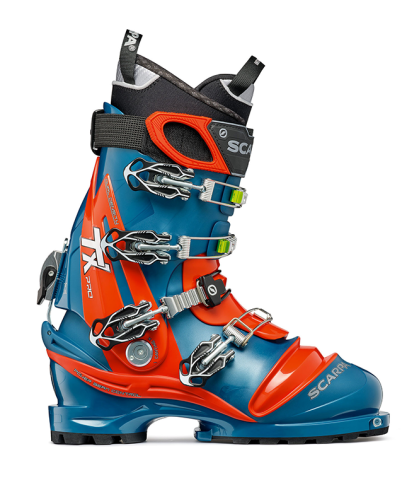
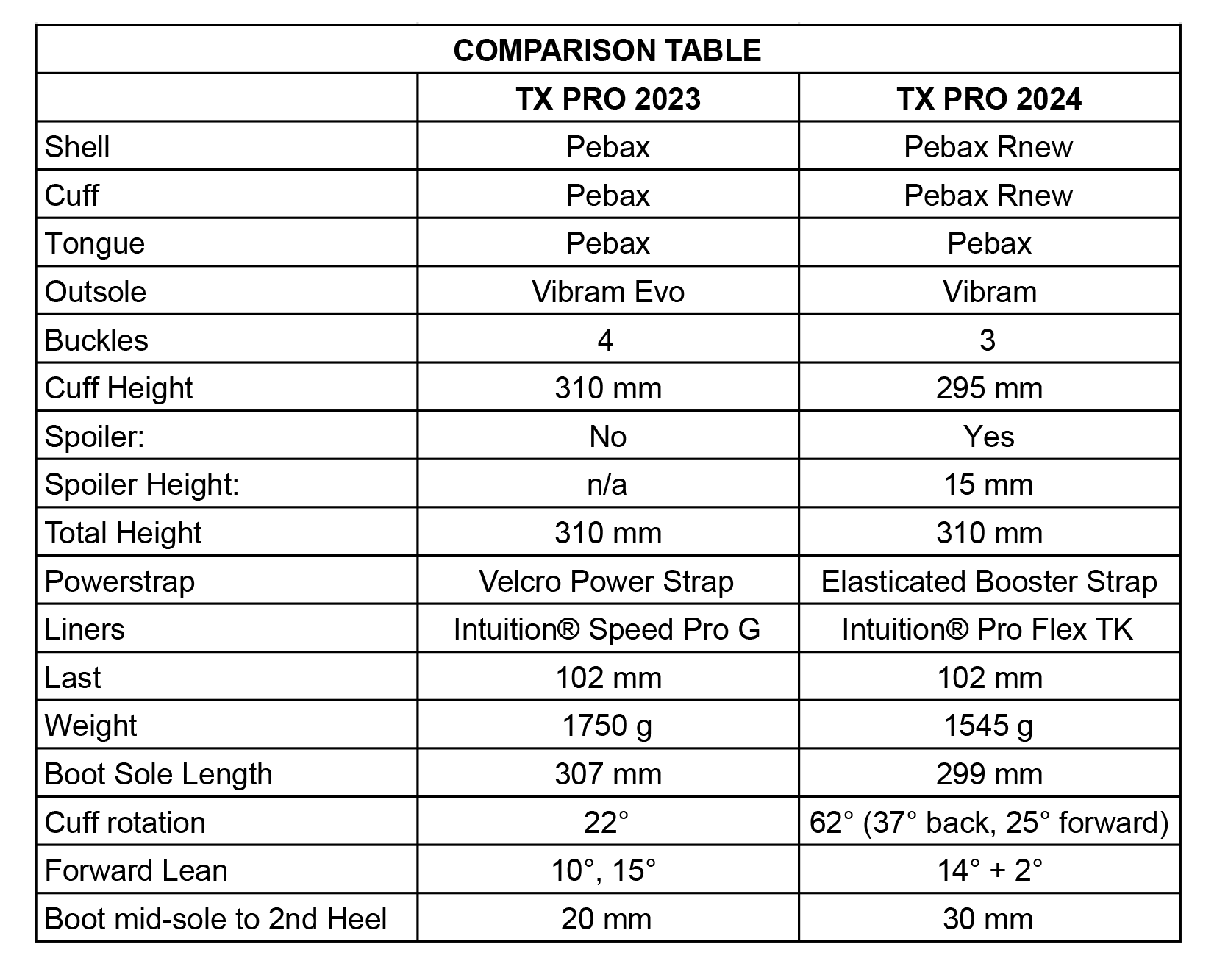
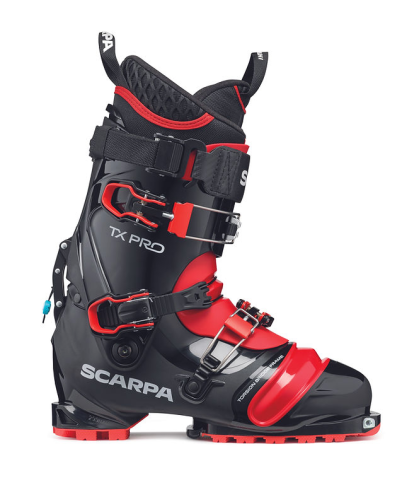
SHELL SIZE / BOOT LENGTH
The new size 27 MP shells are 8 mm shorter and have a shorter heel outer sole. The shell seems to be slightly narrower and closer to the foot giving a snugger fit. Last width stays the same at 102 mm, which should suit most feet. Built with Scarpa’s Torsion Bridge Frame and Triple Injection technologies, the shell is lighter yet laterally stiffer.
Getting geeky: it’s interesting that the boot centre mark on the shell is now 30 mm in front of the NTN 2nd heel, 10 mm forward compared to the previous model. While the distance from the pin holes to the 2nd heel stays the same, being determined by the specs of the NTN boot sole, inside the boot more of the foot is placed in front of the 2nd heel, giving improved foot-binding interaction and control. We understand that compared to the previous TX pro shell the foot is about 4 mm further forward in the shell.
The shorter shell means that when sking the new boots using bindings mounted for the previous model, boot centre will be 4 mm forward.
BOOT TOE
The boot toe has a hybrid design to allow compatibility with both 2-PIN NTN/TTS and NTN bindings. Ideally a boot designed for use only with insert bindings could have a narrower toe unit which would give compatibility with crampons with wire toe bails. NTN bindings however require a wider rounded boot so the new TX Pros have a rounded profile on each side of the toe pins. We found the boots worked well with both the Meidjo and Outlaw X, with a just perceptible movement within the Outlaw X toe unit, which did not cause problems when skiing.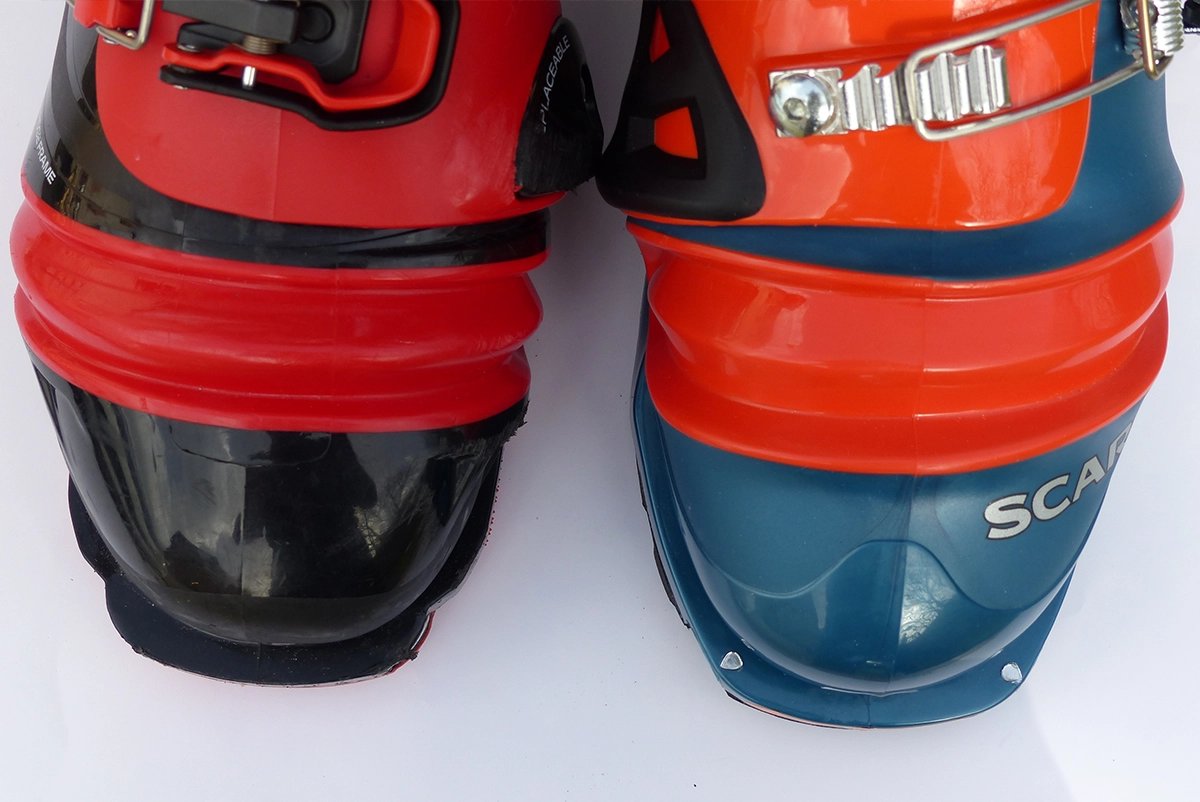
Step-in to the Meidjo bindings was easy but the new boots do not have the metallic spots on the upper surface that are handy to guide the pin holes to the bindings.
CUFF
The new TX Pros have a slightly lower cuff plus an adjustable spoiler, that brings the total height to the same 310 mm as the previous boot. The cuff has one buckle, positioned between the two cuff buckles of the previous boots, plus an elasticated power strap. Scarpa have added small protruding "lugs" on the inside of the cuff, positioned about 4 cm above the cuff retaining screws. The latest Maestrale alpine touring boots also have this feature. When the cuff is locked in ski mode these lugs do not contact the edge of the shell. However at the end of the stride in walk mode, when the lower leg is flexed forward the lugs link up with the shell and prevent further forward movement of the cuff. This may be to prevent the cuff getting damaged when pushed too far forward, or it may be that blocking the cuff against the shell helps lift the heel of the boot at the end of the stride for more efficient skinning.
When skiing in walk mode, the cuff of the rear foot can flex forward until the lugs link with the shell, making the shell and cuff work as a unit and putting pressure on the ball of the foot and the bellows and providing precise weight control.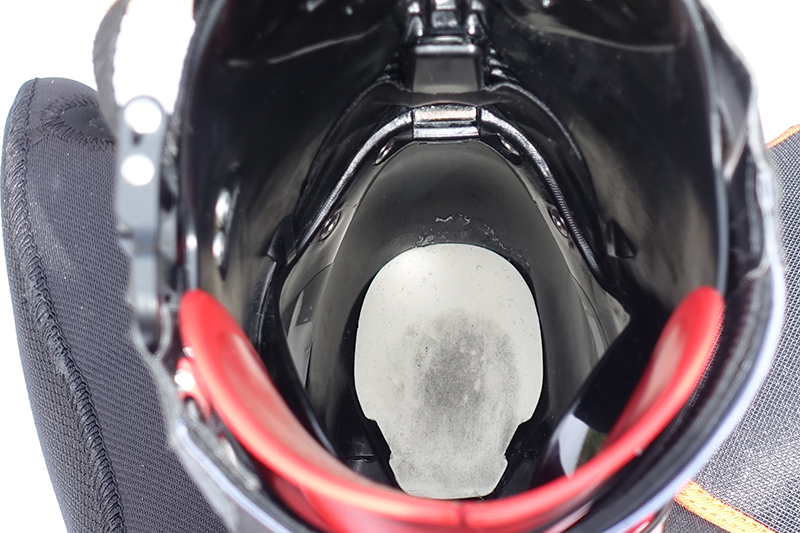
BELLOWS
Scarpa have put a lot of work into the bellows, which now extend down to the base of the boot - the older TX Pros the bellows stopped about 5 mm above the boot shell. The bellows have a less assymetric than the previous design and are also shorter from front to back, 33 mm against 39 mm, giving a more ergonomic flex that corresponds to what your feet are doing inside. Combined with the flex zone of the Intuition liners, flex is natural and we didn’t notice any toe pinch even with a low stance.
I’d put the flex as the same, or slightly stiffer than the older TX Pros, but with a more dynamic “rebound” coming out of the turn. It’s still pretty soft, softer than Crispi boots, but works very well with the shell and cuff, which are now much stiffer.
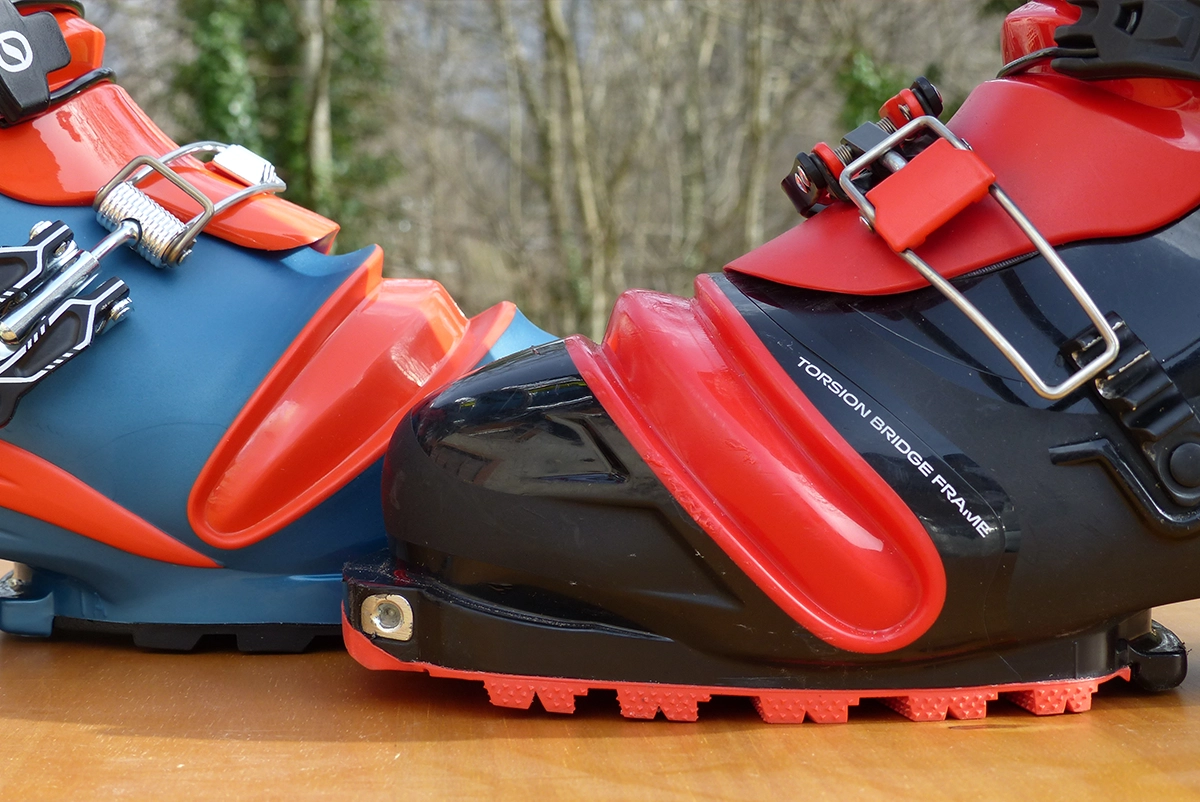
The TX Pros have replaceable bellows protectors just behind the bellows. When skiing narrow and regular width skis these worked well, but aggressive skiers with wide rockered skis will still manage to scratch the softer bellows plastic. If the protectors could use a harder plastic and / or have a higher profile they would protect the bellows even better.
BUCKLES
The new TX Pros come with three buckles. The 1st and 3rd buckles are lightweight DWA aluminium levers with micro-metric adjustment. The 2nd buckle has a plastic ratchet closure mechanism and locks the heel in place to avoid heel lift.
The 1st buckle is reversed with the buckle on top of the boot and the tooth catch mounted on the outside of the boot, just above the NTN 2nd heel.
The cuff now only has one buckle, positioned between the two of the previous boots but this wraps the cuff around the leg securely. The elasticated Booster Strap is equipped with a Recco avalanche reflector and has a convenient “G” shaped hook that makes boot entry and exit quick and easy.
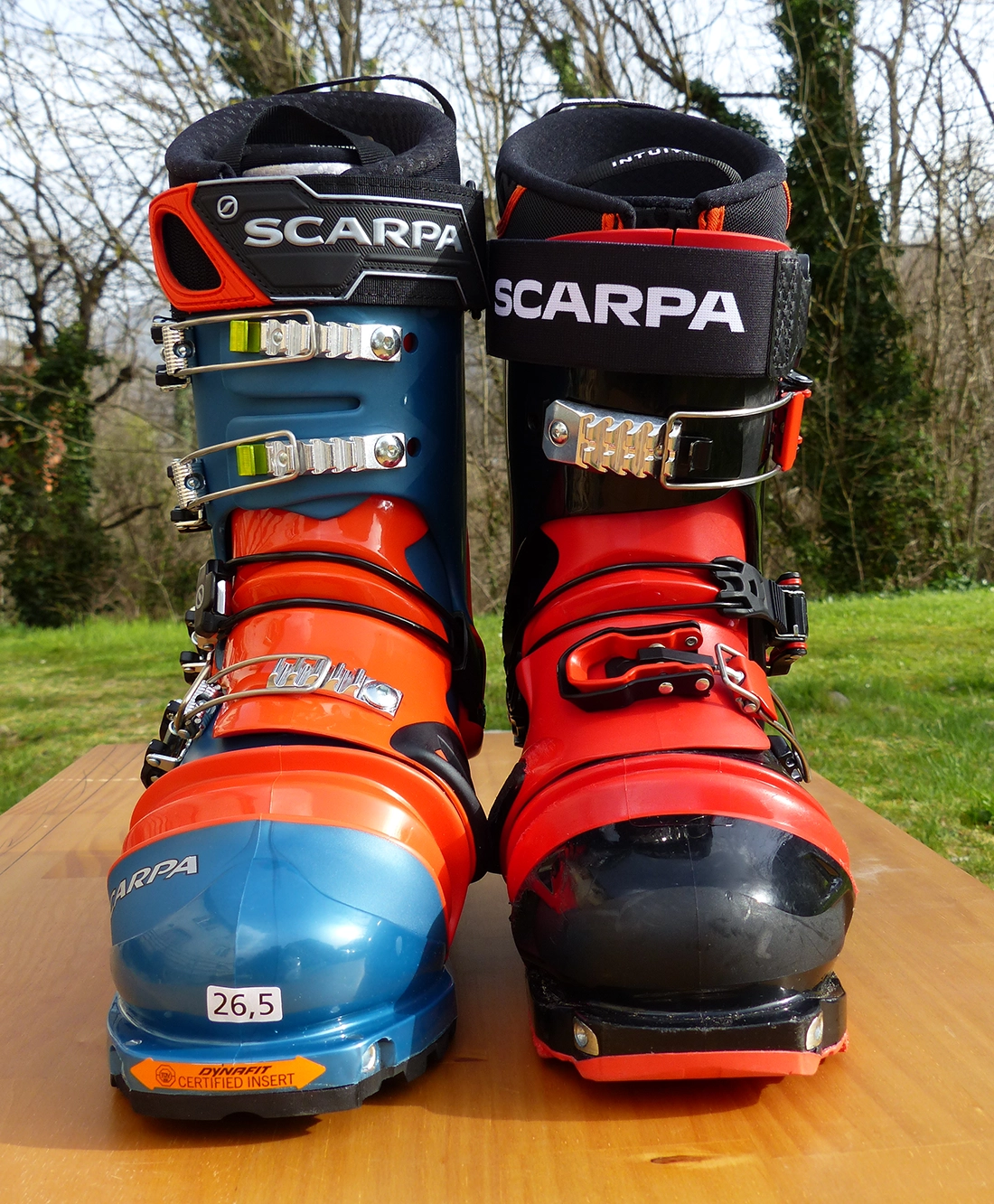
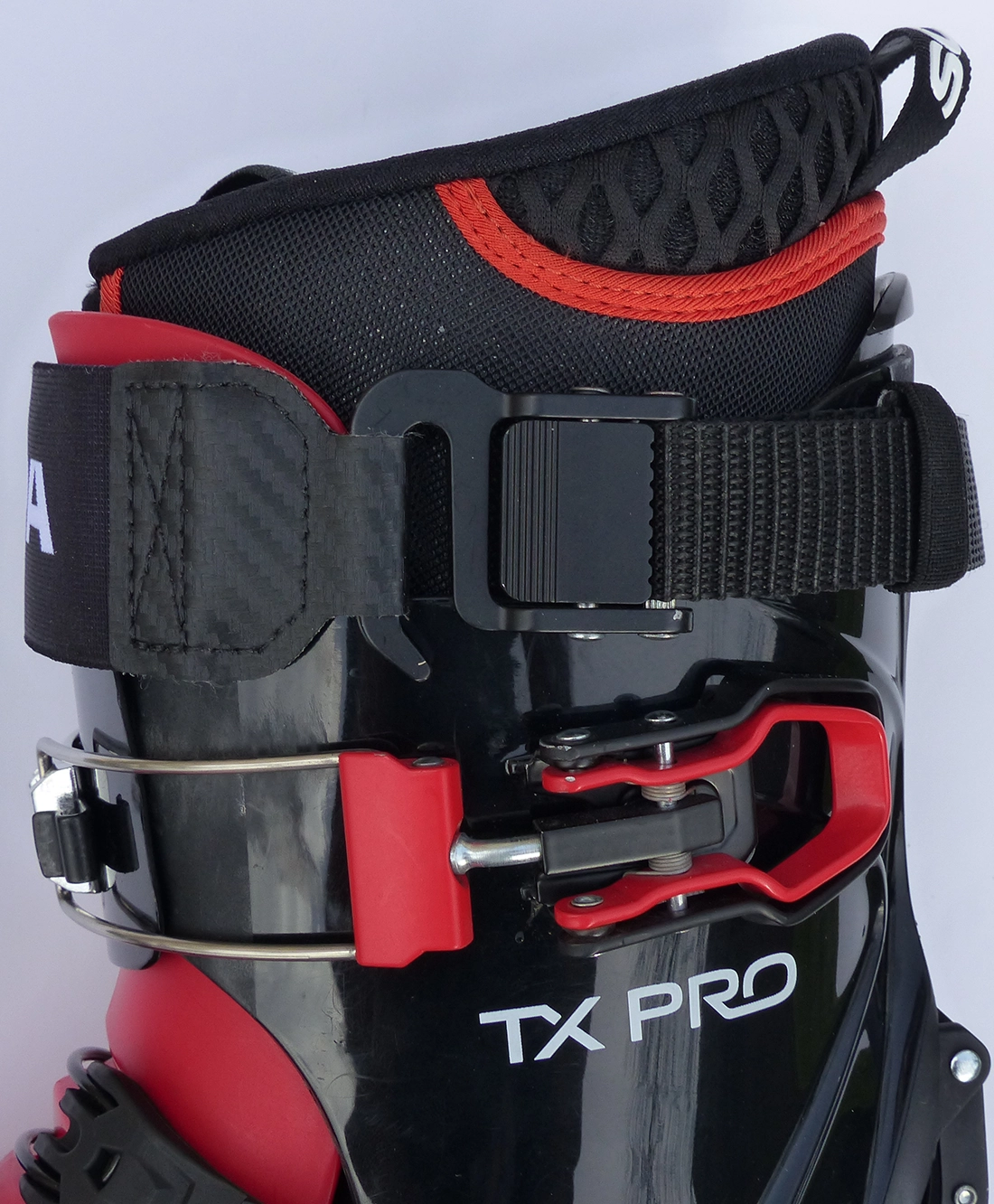
Scarpa’s telemark & alpine touring boots are renowned for the excellent 2nd buckle that passes over the rear of the instep and locks the ankle down, preventing the heel from lifting off the footbed. Until now, the anchor point for the 2nd buckle has been the cuff screw, which meant that closing the buckle limited cuff movement in walk mode. On the new boots the 2nd buckle cable is a separate mounting point so that cuff rotation is freer.
It’s a neat solution which brings us to….
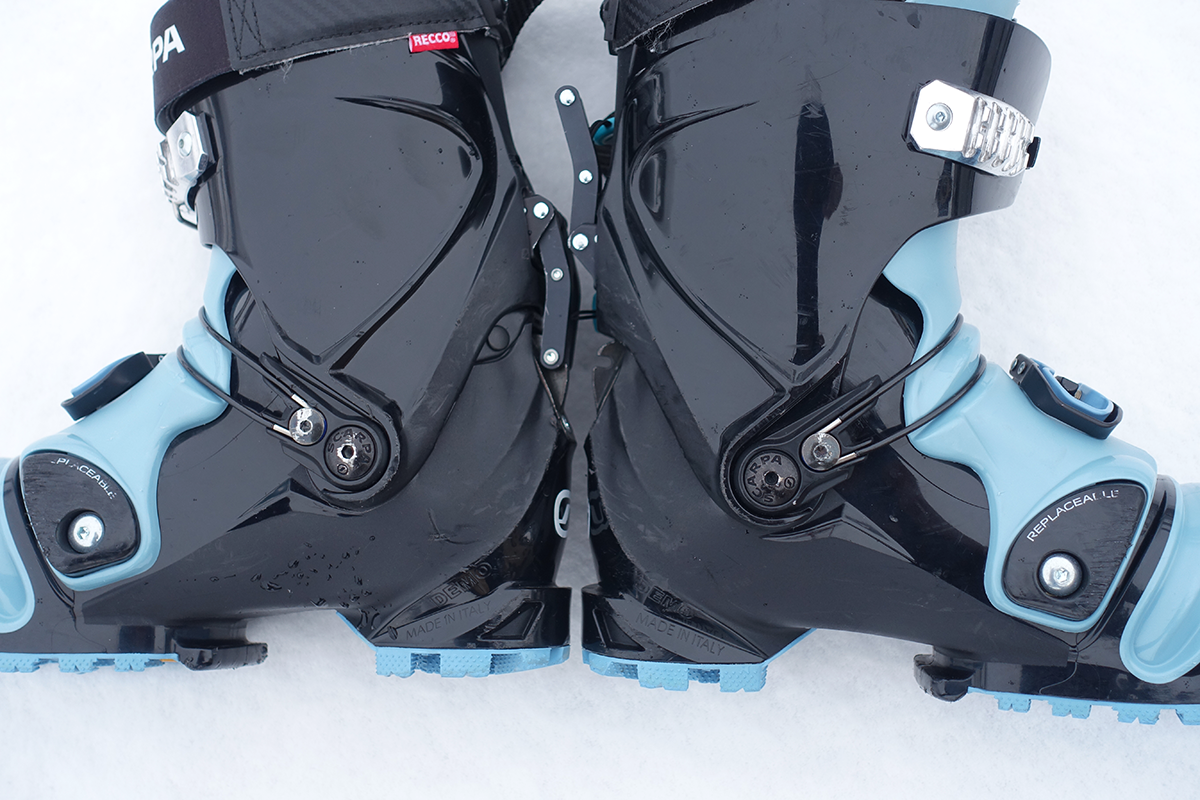
CUFF ROTATION
Alpine touring boot design has advanced in leaps and bounds since 2007. One of the main improvements allowing alpine tourers to leap and bound uphill faster has been the increase in cuff rotation, providing a much more natural gait rather than a constrained shuffle (these improvements eliminated the need for the bellows in AT boots, mentioned above).
The 2024 TX Pros come with a massive 62° of pretty much friction-free cuff movement (37°back, 25° forward), more than the latest free-rando boots and almost 3x the 22° of the older TX Pros.
SKI/WALK LEVER
The Speedlock MLT ski / walk lever has a similar design to those on the Scarpa F1 series boots. It’s light yet solid and easy to switch modes. In ski mode the cuff has 14° forward lean, with the possibility to advance another 2°. In ski mode the cuff drives plenty of power to the ski and the cuff/shell ensemble works well together.
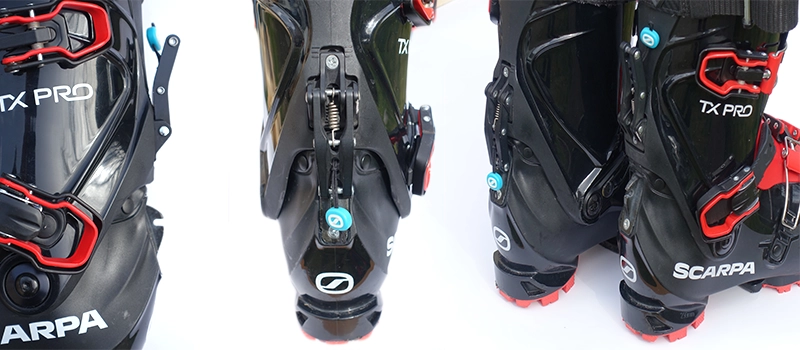
WALK MODE / TOURABILITY
Weighing in at 1545 g per boot (27 MP), the new TX Pros are almost 200 g lighter and just about reach that 3 kg / pair weight that’s deemed a good basis for efficient touring.
Just as in everyday life, we’d been dreaming of more weight loss than was actually attained, but when one considers the complexities of boots with bellows and NTN 2nd heels, 1545 g per boot is pretty good. The lower weight, slightly lower cuff and massive amounts of cuff rotation make these great boots for touring. Skinning was much more efficient thanks to the massively increased cuff rotation and lower weight.
Walking is also easier in the new boots. Despite the flatter sole profile, the lower weight and bulk and relatively soft bellows combine to make them less cumbersome and more agile with more secure placement, handy if you need to hike some sections.
One small downside is that the boots are not compatible with crampon wire toe bails, due to the wider rounded toe shape required for the NTN binding toe units.
The older TX Pros had the same problem and some skiers using Meidjo / TTS Transit / Lynx bindings got the Dremels out and trimmed away the unnecessary excess plastic to get compatibility.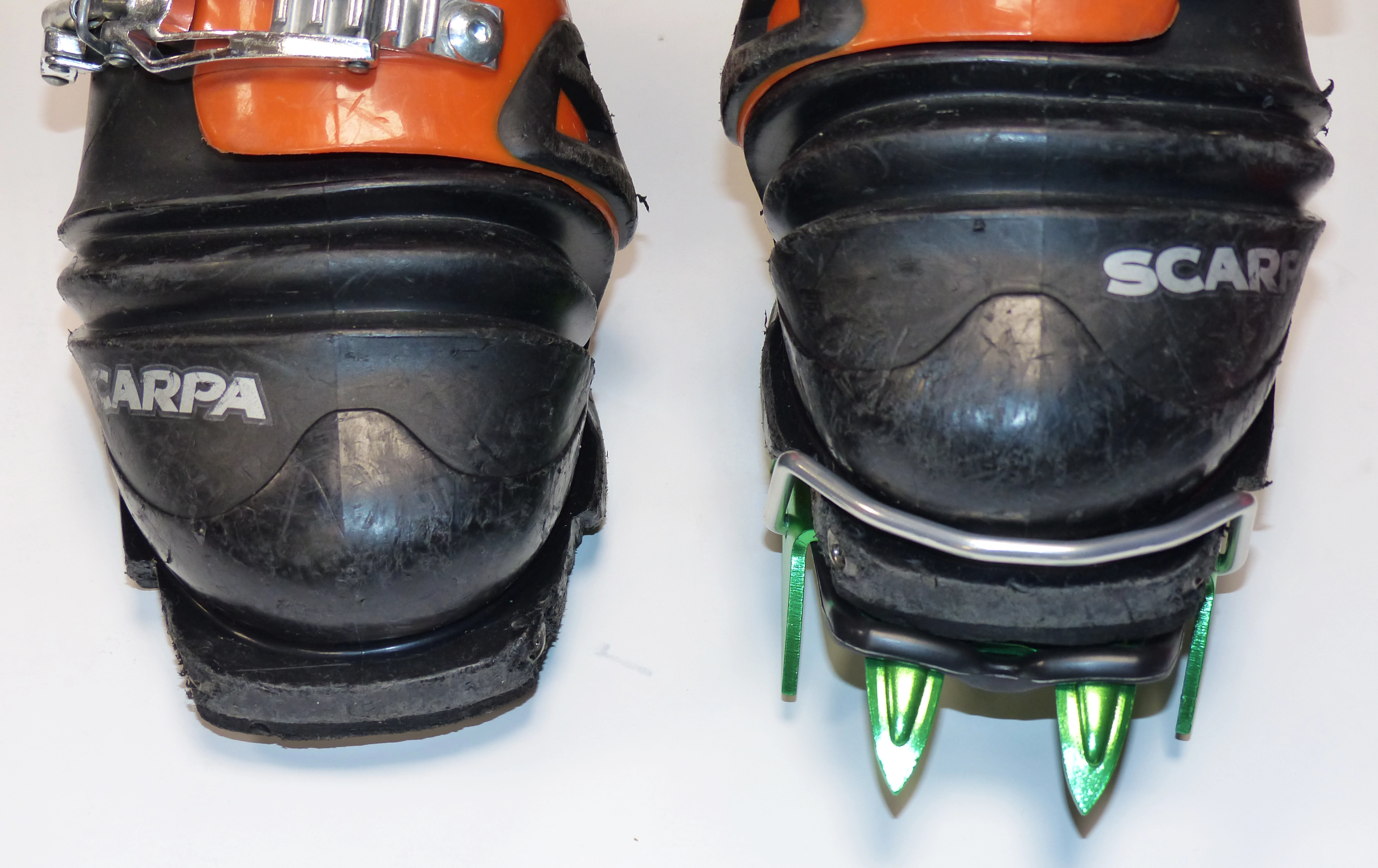
We’ve seen an increase in market share for 2-pin NTN / TTS bindings to the detriment of traditional NTN this winter and maybe in a few years a narrower toe will be possible.
LINERS
The Intuition® Pro Flex TK liners weigh 10 g less and appear slighty thinner than the previous model, but were warm and comfortable.
The TK refers to the neat flex zone above the toes, Intuition’s 1st telemark specific liners. These liners have a tongue that provides more versatility for mixed resort / touring use, and come with eyelets for adding laces to the liner cuff, if required. Some skiers will want overlap liners for added power but for most skiers these will be fine.
Straight from the box the liners were warm and comfortable, providing support and good communication with the shell. Occasionally I could just feel the cuff retaining screws but it wasn't annoying, just part of the "exoskeleton experience" described above. After several weeks skiing I started feeling some heel lift so heat moulded the liners. This solved the problem, heel lift eliminated and boots fitting even better.
The liners come with Scarpa's Ortholite footbeds, providing snug support for the ankle and instep.
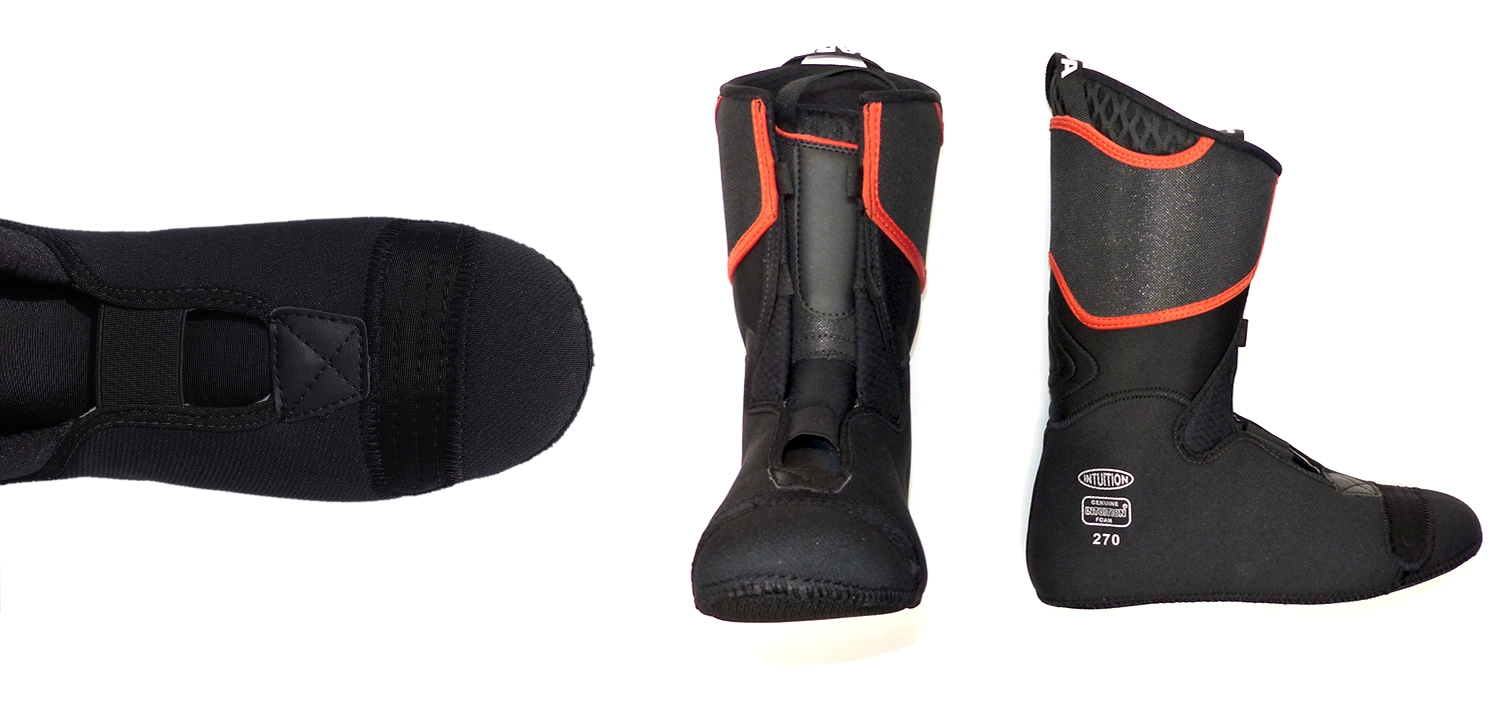
SUMMARY
Scarpa have taken the time to develop what are certainly the most advanced all round telemark boots to date. No other boots combine excellent downhill control with good tourability.
Whether you ski in walk or ski mode, the new TX Pros provide excellent downhill control, combining power and precision.
The 2024 TX Pros will motivate many more freeheel skiers to ski in the backcountry, letting us tour with an efficiency appoaching that of alpine tourers.
Thanks to Scarpa for dedicating the time and resources required to develop the new TX Pros, which we are sure will be in big demand this autumn.
ACKNOWLEDGEMENTS
Thanks to Plein Nord and Scarpa for the loan of these boots.
Thanks to Franck Alary for the action images and feedback.
PRE-ORDER for next winter.
We expect to receive these boots in early October 2024. You can pre-order a pair and we will contact you once the boots arrive.
Scarpa TX Pro 2024
Scarpa TX Pro Women 2024



